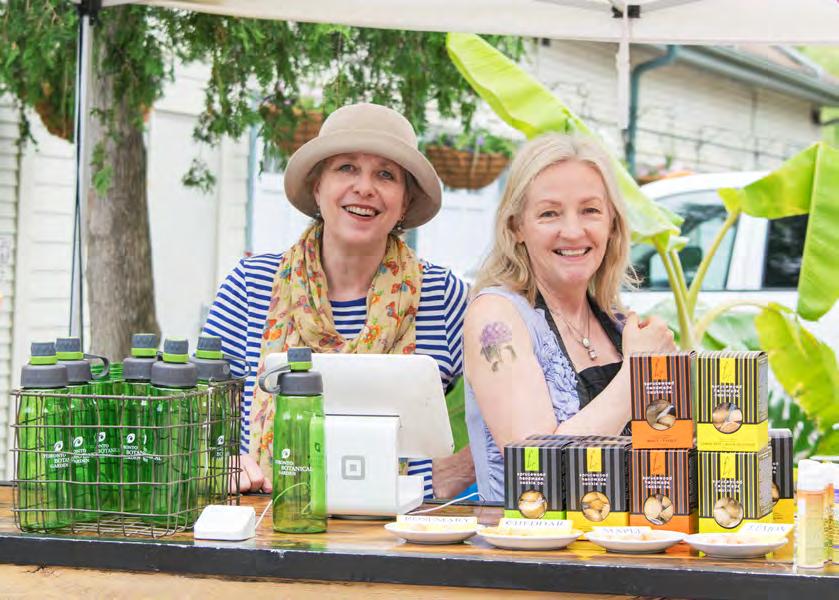
4 minute read
TIPS FOR RAISING BUDDING GARDENERS
IT’S NEVER TOO early to teach a child about gardening. Not only is growing your own food an easy way to encourage healthy eating habits, foster curiosity and responsibility but it’s a wonderful activity for bonding with your children or grandchildren. Here are some fun tips for sowing the seeds for a lifelong love of experimenting with and enjoying nature.
1. Help young children Choose Easy Plants to Grow such as yellow, green or purple beans. Start indoors or out when all danger of frost has passed. Purple beans are fun because they change colour when cooked.
2. Plant a Pizza Garden. Draw a circle in the soil and divide it into wedges. Grow a different topping in each wedge—tomatoes, onions, peppers, garlic, basil, etc. Or, you could plant separate items in containers. Amend the soil with compost. Plan to celebrate later in the summer with a pizza party serving pizza made with toppings from the garden.
3. Make Magic Plant Markers. To keep track of which seeds are planted where, have kids print or paint the names on popsicle sticks (available from craft and dollar stores) and place them in the soil.
4. Make a Garden Chore Chart and include jobs for everyone such as prepare the soil, plant, weed, water, harvest and make food to eat using vegetables and herbs from the garden. Preschoolers, for example, can learn to pull weeds and water seedlings. Five- to seven-year-olds can help rake and prepare the soil. Older kids can research and help choose what to plant. Teenagers can make compost, prune shrubs and mow the lawn.
5. Organize a Scavenger Hunt. Kids of all ages love a treasure hunt and it’s a great group activity. Give each child or team paper, pencil or pen, a bag to hold their finds and a list of what they are to look for. The list can include anything they are likely to find in the vicinity such as a yellow flower, an orange leaf, a white pebble, a feather, etc. You could have themes such as six items of different colours or a list of five items they’ve seen that represent the senses of see, touch, smell, hear and taste. Set a time limit and when everyone gets back sit down and discuss what each child has found.
6. Encourage them to Read About Gardening. Introduce them to 15-year-old Toronto author Emma Biggs who with her dad Steven Biggs has written Gardening with Emma (Storey Publishing). Written for kids by a kid. Or, to Forest Magic: A Guidebook for Little Explorers by Sarah Grindle, a book to take on a walk in the forest (Nimbus Publishing). Or, Wildflower, a retelling of the Hans Christian Andersen fairy tale Thumbelina by Briana Cox Scott, coming out later this month. (Nimbus Publishing)
7. Grow Your Own Jack-O- Lantern. Pumpkins have nice big, easy-to-plant seeds. Start inside in a pot on the windowsill in early spring and transplant outside in an area with lots of room for expansion. Be patient and keep watering.
8. Plant Sunflower Seeds. Find a sunny patch. Plant a handful of seeds and watch them grow. For an early start plant in a pot inside in early April and transplant outside when there is no longer a fear of frost. Most varieties grow 1.5 to 2 metres tall. In fall you can harvest and roast the seeds to eat, leaving a few to plant for next year.
9. Paint Some Rocks. Collect smooth river stones. Wash and dry them in the sun. Paint them all over with a water based acrylic sealer and a foam brush. Paint on any design you like— ladybugs, flowers, hearts, rainbows. Whatever. Take inspiration from the shape of the rock. Dry overnight. Apply sealer with a foam brush. ‘Plant’ outside in flowerbeds, pots or display indoors.
10. Let them grow Vegetables They Enjoying Eating. Kids love fresh peas. Plant them to grow up a teepee support made of three bamboo sticks tied together at the top… Radishes can be planted anywhere and will grow quickly, ready to harvest in about 30 days… Carrots will grow well in a deep pot. Try growing purple ones… Lettuce is quick to grow from seedlings. Try a tray with a few different varieties.
11. Press Flowers and Leaves between the pages of heavy books. Use them to design cards, book marks and writing paper. Cover with see-through adhesive plastic. Or, encourage youngsters to make a pressed flower album using a small plastic-sleeved photo album.
12. Keep a Garden/Nature Journal. A great way to get kids outside with binoculars and magnifying glasses. Encourage them to make notes, draw pictures and keep track of their observations of trees, grasses, birds, insects and more. And, of course, to write about their gardening successes and failures as a learning exercise for next year.
13. Create a Fairy Garden in a container with a large open surface area to accommodate as many small plants and garden décor pieces as possible. Tin buckets, wicker baskets, wheelbarrows, old baby baths, wooden crates are all good containers for a miniature garden. Be sure to put drainage holes in the bottom so plants don’t rot.
14. Challenge children to Use Their Senses while exploring outside. Sniff trees and flowers. Listen to birds and fountains. Touch rough bark and soft leaves such as lamb’s ear. Look for different colours and textures. Taste fresh herbs, fruits and vegetables.
15. Let kids Use Real Garden Tools. They are much more durable than ‘play’ tools and will help children gain confidence in the garden. You can get small versions of spades, rakes, hoes and more. Teach kids what each one is for and how to look after them.
Tips for Raising Budding Gardeners by Lorraine Hunter.









